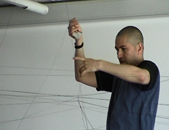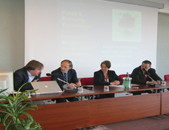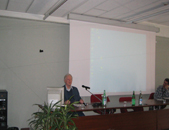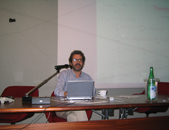Complexity Symposium Art, Complexity and Technology: Their Interaction in Emergence
Description
Exystence Symposium in Turin on Art, Complexity and Technology in May 2005
The Symposium has brought together scientists, artists, complexity scholars and those working with complexity and technology to explore the interaction and co-evolution of ideas and experiences in the three domains; a different use of technology should emerge through the language of representation and of the medium in representation.
Some of the work show at Turin in May 2005 was shown again at UCL in Oct 2005.
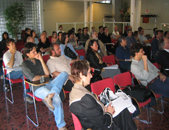

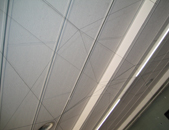

Complexity in Temporal Instrumental Arts The role of the tangible interaction
Presenters
- Annie Luciani — Directrice du laboratoire ICA Ingénieur de Recherche — Ministère de la Culture, France
Description

Annie Luciani is a research engineer at the French Ministry of Culture. She received a degree in electrical engineering (ENSERG 1973) and a PhD in computer science (1984) at the INPG in Grenoble France. She is one of the founders (with Claude Cadoz and Jean-Loup Florens), of the French (ACROE-ICA) research group in Grenoble (France) in 1976. ACROE-ICA laboratory is a Computer Arts Laboratory that pioneered the design of force feedback devices in 1976 from scientific and artistic considerations in Computer Music and Computer Animation. Since 1999, she heads the ICA laboratory of INPG-France. She participated in the design of the Cordis-Anima language physically-based modeler-simulator (1976) using force-feedback to control in real-time, visual and sound simulations. She is in charge of the research and creation in computer graphics at the ACROE-ICA research Group. She is in charge of the use of physically-based computer models and haptic interaction in artistic creations and artistic schools (animation, choreography, music). She produced two artistic works: Esquisses and Memoires Vives.
Abstract:
In this talk we will examine the role of the dynamic coupling in the instrumental relation between humans and instruments in the generation of complex sensorial events as needed in Music, Dynamic Visual Arts and Choreography. Temporal Arts are those based on sensible temporal phenomena, as sounds or evolving visual phenomena. The term ‘instrument’ is usual in Music, in which it refers to the physical object that is necessary to produce the sound and which is played by the musician-instrumentalist. But more generally, all temporal arts, i.e. arts that are based on temporal evolution of sensible data, as Music, Dynamic Visual Arts (kinetics sculptures, animation), Choreography, needs necessarily a physical medium to be acted and then the concept of instrument can be generalized at all the dynamic arts, whatever the sense that is stimulated (hearing, seeing, touching). During the instrumental interaction (playing a cello, rubbing a surface to produce a striking sound, to mould a past, to bounce on the ground by hitting it, etc), the physical body of the instrumentalist and the instrument are closely dynamically coupled. In terms of interaction concepts, it corresponds to the case in which the physical object is within the hand or within the body itself. This situation of ‘prosthetic’ or ‘embodied’ instrument is very different from conventional computer-human interaction in which the user is immersed in the environment, whether in a landscape-like open loop interaction or is manipulating an object via an interaction metaphor with a stick or a mouse. Such situations are ‘open loop situations’ that are not able to provoke emergent complex state changes and transients in the produced sensible phenomena. Conversely, when we are playing cello, or are rubbing a glass with our finger, such complex coupling between the instrumentalist and the played object able to produce non predictable emergent changes: timbre changing, sticking, creaking, etc that are constitutive of the quality and the richness of the produced and perceived sounds. We can say that a musical instrumentalist is playing ‘with chaos’, trying to master it and that the listener is hearing this ‘subtle struggle’ with its success and its failure. Then musical instrumental situation (as well as the dance performance or the puppet manipulation in visual or theatre arts) is a representation of the complex relation between the instrumentalist and the world, through the produced sounds (resp. the visual evolving events). Consequently, the introduction of force feedback devices to interact physically with virtual objects and virtual instruments, has to be understood not only in allowing humans to perceive ‘haptically’ the virtual object, - that is in fact a secondary issue - as usually considered today, but as a necessary component to produce complex auditory and visual sensible emergent events by means of closed-loop instrumental situation. The talk will be illustrated by several examples of computer representation of instrumental situation in music, dance and visual arts.
Some relevant references (in French)
- René Thom. Esquisse d’une sémiophysique. Interéditions. 1988
- Jean Petitot. La forme. Encyclopædia Universalis, XI, 712-728, Paris. 1989.
- Claude Cadoz. Le geste : canal de communication instrumentale. TSI Vol 13, n°1/1994. Herme
Interfacing with Evolution: Towards a Self-organizing Architecture
Presenters
- Professor John H. Frazer — AA School of Architecture, London, UK,
- Neil Garshenfeld — Director The Center for Bits and Atoms — Cambridge, MA
Description

Professor John Hamilton Frazer is a systems design consultant and advisor to Gehry Technologies Digital Project Ecosystem. He has been pioneering the development of intelligent and interactive building design systems and evolutionary design computation for over thirty years. His research in this field has been developed at the Architectural Association, Cambridge University, the University of Ulster, and most recently at the Hong Kong Polytechnic University where he was Swire Chair Professor and Head of School of Design. He is a Fellow of the Royal Society of Arts, a Fellow of the Chartered Society of Designers and has honorary professorships from the Universities of Beijing, Dalian, Fudan and Shandong. He founded Autotectonica and was Chairman of the award winning Autographics software development company. His work has been presented worldwide in lectures and conferences and extensively published in journals and books, including the seminal An Evolutionary Architecture.
Abstract
Generative and evolutionary computing techniques are proposed to achieve the co-operative evolution of a sustainable future architecture.
The implication is a fundamental realignment of the roles of the user, the environment, the tool and means of construction. The computer becomes an evolutionary accelerator and the means of prediction and production; the user plays an active role in establishing the criteria for the validation of virtual prototypes for sustainable construction in the real world; the architect creates and sows new design concept seeds expressed in the genetic language of artificial form; and the environment is actively involved to effect the growth of the seeds so that each is unique to its situation.
This new model will be complete when design information is fully embedded in the intelligent and interactive substance of a built environment and is able to interface with the natural environment. Self-knowledge, self-assembly, self-modification and self-repair will finally lead to self-organization. The natural and artificial environments will merge, enabling the built environment to become integral to the very shaping of our planet’s future. This self-organizing process is known as autotectonics.
Based in the first instance on an analogy with the operation of natural biological processes, the model moves on to suggest a post-evolutionary strategy that transcends the analogy with nature and in turn becomes a means of interfacing to the evolutionary processes of nature. The autotectonic result may be a new form of designed artefact interacting and evolving with natural forces through pervasive computing and artificial intelligence.
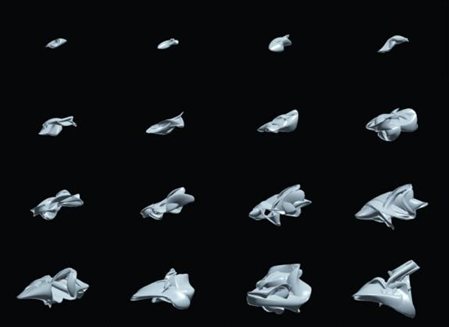
Interactivator: Networked Evolutionary Design System
John Frazer, Julia Frazer, Manit Rastogi, Peter Graham, Patrick Janssen
Architectural Association, London, 1995
Documents
Bio-inspired Techniques for Consciousness-aware Multi-sensory Artistic Installations
Presenters
- Dr Manuel Moreno Arostegui — Technical University of Catalunya, Spain
- Raquel Paricio Garcia — Technical University of Catalunya, Spain
Description
Biographies

Dr. Juan Manuel Moreno Arostegui, PhD in Telecommunications Engineering, holds currently an Associate Professor position at the Department of Electronic Engineering, Technical University of Catalunya (UPC), in Barcelona, Spain. He is the coordinator of the POETIC IST project, and in the past he has participated in other projects funded by the EC in the area of programmable devices (RECONF2 and FIPSOC projects) and artificial neural networks models (ELENA project). His research interest include bio-inspired computing techniques, artificial neural networks models and architectures for programmable devices.

Raquel Paricio Garcia graduate in Fine Arts and currently a PhD candidate at the Technical University of Catalunya (UPC) about Art, Science and Technology: Sensory interfaces and systems. He has been teaching in different University schools of Barcelona (ESDI, ELISAVA, IDEP, UB). She has participated in exhibitions held in Mendel Art Gallery Saskatoon, Fundacio Tapies, Media Festival Canarias, Digital Culture Festival, Festival at the Museum of Contemporary Art Chicago, Eliterature Festival, Primavera Sound, Barcelona, Agora Möbius and University of Valencia. Her research interests include body consciousness and expression and multi-sensory environments and interfaces.
Abstract
The talk will concentrate on the aspects to be handled in the development of multi-sensory artistic installations that are designed to improve the self-perception of the users as a step towards achieving higher consciousness levels. It will be explained how principles derived from an inspiration in the way biological systems perform complex tasks (such as adaptation to the environment, development, self-replication, self-repair and learning) may help in the construction of artistic installations developed for these purposes. A practical example will be provided by means of the POETIC-Cubes project, an artistic installation currently under development where the user is able to interact with nine autonomous robots.
Art vs. Complexity: The two-way Street
Presenters
- Michael Petry — Museum of Contemporary Art, London
- Mateo Willis — Artist, UK
Description
Michael:
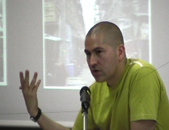
Mateo:
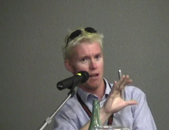
Superstring Installation (proposed by Michael Petry):
This would be an interactive self-defining, ongoing project that would take place at the start of the conference and run throughout its 2 days. A final visual element will emerge from the participation of all the conference members, speakers as well as attendees.
According to lead theorists (like David Peat) super strings run throughout the universe taking material from one end to another. Yet they interact on our perceived notion of the universe at such an infinitesimally small level, that we do not see or feel these transfers. Such strings are said to pass through our physical bodies continuously going through the space between atoms, and subatomic particles. Particles like neutrinos are so un-interactive that they pass through us without ever disrupting our subatomic elements. Petry would ask each person to attach at least one section of string to different parts of the room (with staplers provided) at the start of every session. They could of course do many, or use the break periods to make even greater interventions.
In essence, the room will become wrapped in miles of elastic string, going from floor to wall, ceiling to door, wherever anyone wanted to attach two end points. Viewers would eventually be able to enter and bounce around the space.
Often it is asked how artists can lead scientists to an understanding of the world, and while there are many examples, Petry would suggest that the visual metaphor of the bound room being a pattern for space, and yet a bound restricted space presents a paradox similar to that of the Wormhole. In a Wormhole, given the technology, we could as we exited one, see ourselves enter it. In a bound room, the depiction of freedom and its boundaries can be drawn and complexity will see art and science merge.
Stimulating Creativity in Music: Demonstration of Work and Discussion
Presenters
- Andrea Valle — Lagrange Fellow
- François Pachet — SONY Computer Science Laboratory, France
Description

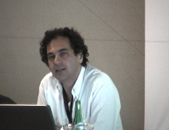
Biographies
**François Pachet** is a Civil Engineer, and got a Ph.D. and Habilitation à diriger des Recherches from University of Paris 6. Assistant Professor in Artificial Intelligence and Computer Science at Paris 6 University, he set up in 1997 the music research team at SONY Computer Science Laboratory (Paris), where he develops the vision that metadata can greatly enhance the musical experience, from listening to performance. François Pachet is the author of over 70 scientific publications in the fields of musical metadata and interactive instruments.
Abstract
I will ask the question “Can we design machines that enhance our individual musical creativity?” I propose an answer based on the notion of ‘reflexive interactions’: interactions in which users are confronted with a representation of their own musical personalities. The Continuator, an instance of these machines, is an interactive musical style learning system that enables musical dialogues between users and virtual copies of themselves. As such, the Continuator creates psychological effects in the behaviour of users, including ‘Aha’ and Flow-like experiences. I will show some experiments conducted with professional musicians improvising and composing, and with children in kindergarten, which suggest that the answer to the initial question is positive. Finally, I will show that the creation of a fully-fledged musical piece involves the management of longer term structures that require other capacities.
The Art of Behaviours: moving Towards Life in Simultaneous Realities
Presenters
- Professor Rebecca Allen — MIT Media Lab Europe
Description
Biography

Professor Rebecca Allen is an internationally recognised artist, a research scientist and a pioneer of 3D computer graphics, human motion simulation and interactive media. She was director of the Liminal Devices research group at Media Lab Europe in Dublin until the lab’s closing in February 2005. She holds a Professorship at the Department of Design and Media Arts at University of California Los Angeles (UCLA) where she was founding Chair of the department and founding Co-Director of the UCLA Center for Digital Arts. From 1996-2002 she directed the Emergence Project at UCLA, an Intel funded research effort involving artificial life, 3D virtual environments, augmented reality and unique multimodal interfaces.
Previously, Allen was Creative Director/Executive Producer and 3D Visionary at Virgin Interactive Entertainment; she was a member of the world-renowned NYIT Computer Graphics Laboratory and MIT’s Architecture Machine Group (predecessor of MIT Media Lab). Allen has worked extensively in Europe and the US, producing commissioned projects in Spain, Germany, Italy, England, New York and Los Angeles. In addition, she has designed and directed research-oriented projects for numerous clients including CBS, NBC, FOX, PBS/Nova, BBC, TVE (Spain), Time Warner, Island, Mattel, Philips, Nintendo, Taejon World Expo, Seville World Expo, Apple and DARPA. Her artwork is exhibited internationally and is part of the permanent collection of the Whitney Museum of American Art and Centre Georges Pompidou. Her many awards include an Emmy award for Outstanding Individual Achievement in Design.
Abstract
Global networks, virtual environments, artificial life, embedded sensors and pervasive computing are all examples of technologies that mirror the complex behaviours of the real world while blurring the boundaries between physical reality and virtual reality.
This technology will, in turn, affect fundamental human behaviour as we increasingly find ourselves navigating the liminal zone between the virtual and the real. It will ultimately call for innovative techniques of procedural art and design based on embedded rules of aesthetics; for aesthetics will play a crucial role as we move towards life lived in simultaneous and mixed realities.
Kovalevsky's Top and the Theatre of Complexity
Presenters
- Luc Steels — VUB, Brussels and Sony Computer Science, Paris
Description
Biography
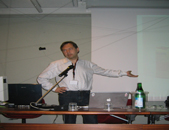
Luc Steels studied computer science and electrical engineering at MIT (USA) and linguistics and philosophy at the University of Antwerp (Belgium). He is a professor of computer science and artificial intelligence at the University of Brussels (VUB) where he founded the VUB AI laboratory in 1983. End of 1996, he founded the Sony Computer Science Laboratory (CSL) in Paris as a sister lab of Sony CSL-Tokyo. This laboratory conducts fundamental research in areas that may significantly impact the future of Information Technology. Steels has published a large amount of scientific papers and a dozen books, including several books on the origins of intelligence in autonomous robots.
Steels is interested in the fundamental problem how cognition may have originated. He has been conducting a series of experiments in which robotic agents develop sensory-motor competence by interacting with the environment and each other. More recently he has been focusing on the origins of language as a way of bootstrapping these robots towards cognitive levels. By viewing language as a complex adaptive system, significant results have already been achieved in the domains of phonetics, lexicon, meaning and syntax.
Abstract
Luc Steels will report on a project with the French theatre director Jean-Francois Peyret to explore and communicate fundamental concepts of complex systems science through the medium of theatre. The piece will premier at the Avignon theatre festival, July 2005, and tour major theatre houses in Europe in the spring of 2006. The project is centred on the fascinating female Russian mathematician Sonya Kovalevsky who was at the centre of mathematical developments in dynamical systems towards the end of the 19th century, and who played a courageous pioneering role to give women access to scientific education and research. During this period, Weierstrass (Kovalevsky’s mentor) completed the arithmetisation of analysis, and new methods of integration were being discovered and applied to celestial mechanics and other physical systems. However the first cracks started to appear in the Laplacean dream that the world would be completely predictable once we know the equations describing it. Kovalevsky was an early contributor to these developments by her study of the ‘Kovalevky top’, which initiated the investigations in the integrability (and non-integrability) of non-linear systems.
Exploring the fundamental concepts of dynamics and complex systems in a theatrical medium is an enormous challenge. Our goal is not to make a ‘historical’ play but rather evoke fundamental ideas about the nature of mathematical and scientific imagination through dialogs, movement, and images. The main figure is Kovalevsky herself, but Poincare, Weierstrass, and Mittag-Leffler are present as additional ‘personages’.
Documents
Robots, Art and Complexity Science
Presenters
- Professor Jeff Johnson — Open University, UK
Description
Biography
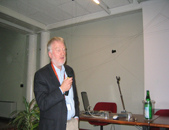
Professor Jeffrey Johnson is Professor of Complexity Science and Design at the Open University. He has researched both physical and human complex systems, and the interactions between them. With Dr Hirst he organised a nationwide children’s robot design competition with the BBC Blue Peter television programme, and is one of the founders of the international RoboCupJunior movement in which includes children creating robots that dance. He believes that robotics will play a major role in the development of the science of complex systems.
Abstract
Creating robotic systems has proved extremely attractive to many artists, and a variety of examples will be shown. Robots are defined to be autonomous machines that can interact with their environment. Sensors enable information about the environment to enter the robot, and actuators allow the robot to act on the environment. Some robots are reactive, linking sensors directly to actuators, giving kinds of reflex actions. Some robots have cognitive abilities that enable them to process their sensory information and use their actuators in purposeful ways. This may, or may not, be viewed as intelligent behaviour. Some robots have embodied intelligence where apparently purposeful behaviour emerges from the construction and physical properties of their components e.g. a rubber arm can twist back to its original position without the need for further cogitation or power. Generally artists want audiences to engage with their creations, and artists are naturally attracted to robotics as a medium of exploration and expression. Robots can be engaging and fun, and they can behave in unexpected and provocative ways. Robotic objects can sense and respond to the viewer or audience, opening up new interactive possibilities for the artist. In many areas of life, art is a driver of innovation and discovery, and we argue that robotic art can be a driver of innovation in the science of complex systems. Robot communities form an intermediate class of complex system, more complex than many physical systems but less complex than human systems. Robot systems allow replicable experiments that are impossible in human systems. But robot art takes us beyond this. Artists observe and experiment in a different way to scientists. They do not necessarily form or test hypotheses, and the outcomes of their experiments may be completely unpredictable. The divergent experiments of artists take us to parts of complex systems space that might never be visited otherwise. The nature of robotics allows us to make extensive observations and measurements of such space. This combination gives the potential for new insights into the fundamental questions in the emerging science of complex systems.
